
If Bing Crosby can live in harmony with a coyote, surely we can… Photo from USC Digital Library
If there is an animal that is the epitome of the urban wilderness it would be the coyote. Disparaged by the American settlers and faced with a concerted effort to by the U.S. government to wipe them out, coyotes not only managed to survive but to expand their range from the American southwest to almost all of North America. Hated by the white settlers, the coyote was held in high esteem by the Native American tribes that shared the land with them.
Coyotes lived in Southern California since the Ice Age. But as the modern city of Los Angeles and its endless suburbs rose, the coyote was pushed out of much of the area. But as in many Native America myths, the coyote is a trickster and doesn’t easily give up.
Each day I get postings from Nextdoor, a social media site that connects neighbors. Most postings are about missing dogs, local events, and petty crimes. About a year and a half ago, a new type of posting starting appearing – coyote sightings. You would have thought Lucifer himself was walking down the street.
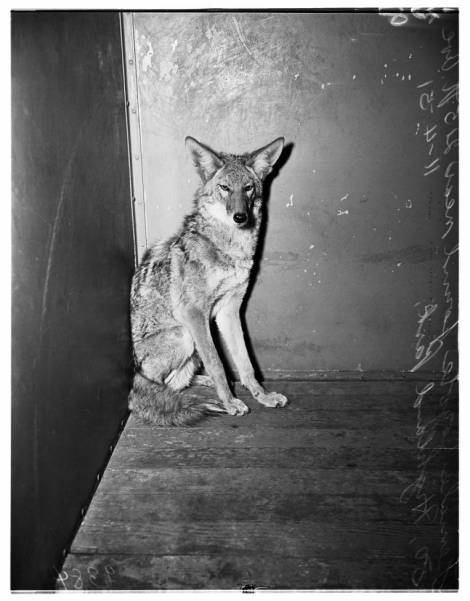
A coyote picked up in Highland Park in November 1951. Before 1994, the Los Angeles Department of Animal Services trapped and killed coyotes. Now they use public outreach, education, and use of deterrents. Photo from USC Digital Library
I was familiar with coyotes. The last place where I lived was a large piece of property where my wife and I rented a house on the top of a hill. At least two coyote packs lived on the hill and we heard them many late nights yelping and howling. Driving out of the neighborhood, we would encounter them on the road. They never ran away, but casually saunter off.
Noticeable about coyotes is they don’t react like other wild animals. Upon being spotted they don’t quickly flee or hide. They will look at you. Not like a deer would, all tension and ready to bolt. Coyotes study you, curious. Behind those intense eyes, there is a mind thinking.
I think that scares some people. Expecting animals to flee, that curious watching is seen as a threat, as if the coyote is getting ready to charge. We city folks are use to our squirrels and birds that quickly dart out of our way. Our larger animals are dogs and how a dog looks at you can never be mistaken for how a coyote looks at you.
Now, don’t get me wrong, coyotes are wild animals and need to be treated with caution, especially with small children and pets. And several people did report on Nextdoor about their cats or dogs being attacked and killed by coyotes. Soon any animal death was blamed on the coyote whether a coyote was seen or not. “Why won’t animal control do anything?” people wanted to know.
The reality is the coyote is in the city to stay. And while animal control generally won’t trap them, it probably wouldn’t matter if they did…

I’d recently finished reading ‘Coyote America’ by Dan Flores (from Basic Books). A wonderful book, it traces the history of the coyote and their relationship to another species, humans. Incredibly adaptive, coyotes will change their behaviors to match environmental pressures on them. When food is plentiful and left in peace, they form packs, have small litters and establish a relatively stable population. In hard times, the packs break up and the coyotes will live more solitary lives. Litters are larger, increasing chances of some pups making adulthood. And the animals go looking for safer refuge.
As Dan Flores maps out, it is this adaptability along with our relentless attack on coyotes that brought them to the cities. As American settlers spread out across the continent, they begin to kill off any critter that was perceived as a threat. At first, their firepower and traps were directed towards wolves along with bears and cougars. These animals, while powerful and intelligent, were also very fixed in their behaviors. Unable to change, they were pushed nearly to extinction. Initially, even the new National Parks provided no refuge for these predators as park rangers would killed them off so there will be more desirable animals for visitors to see – elk and deer.
With wolves and grizzlies almost completely wiped out in the continental U.S., the focus shifted to the coyote. The campaign to wipeout the coyote wasn’t just the action of farmers and ranchers, but was backed by federal and state governments, pouring millions of dollars into the hunt, deploying squads of hunters and laying out tons of poison. Millions of coyotes were killed. And while some areas became coyote free, for a time, the plan was a failure. In the Pacific Northwest and the Midwest and South, a new visitor started showing up. They liked what they saw, settled down and started to raise a family.
But the government only double down in their efforts and soon the East and New England had coyotes. The fact that we already wiped out most of the wolves didn’t hurt either. This continuous assault upon the coyote population forced them to continue to expand. It was only a matter of time before they started to show up in the cities.
Coyotes had already learned to live in the presence of humans before Columbus. They found a niche living near Native American settlements which deterred wolves, the main predator of coyotes. So it was only a matter of time before the coyote started living in the city. Ironically, one of the main factors that held off coyotes from moving downtown were the descendants of wolves — dogs. As big urban areas formed with the industrial revolution, loose and feral dogs roamed the streets causing all the problems that coyotes are often accused of. With new regulations and animal control departments, wild dogs were taken off the street and the door was opened.
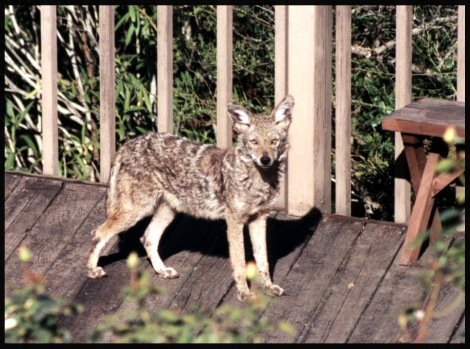
Though wary, coyotes are naturally curious and inquisitive. Photo by Steve Jurvetson from Wikimedia Commons
Los Angeles, with its extensive urban-wilderness interface, is probably one of the first cities to have urban coyotes. The biggest worry for most people is the safety of their pets, especially cats and small dogs. Truth is, coyotes do at times attack and kill pets, but not as often as they’re blamed. Sometimes the pets are not killed as food, but because they are seen as competing predators. In my neighborhood, any dead or missing cat is blamed on coyotes. But we had dead cats before the coyotes appear with many killed by traffic and feral and loose dogs. In the last few weeks, two large dogs were seen in the neighborhood, on several occasions, killing cats.
Another fear is people being attacked by coyotes. While coyote attacks are rare, they have increased as coyotes get more habituated to living among humans. In the paper Coyote Attacks On Humans, 1970–2015: Implications for Reducing the Risks from Fall 2017, authors Rex O. Baker and Robert M. Timm survey reports of coyote attacks in California as well as in the rest of the United States and Canada. One researcher they quoted indicated that before 1961 no record or indication of a coyote attack on a human could be found. But from 1977 to 2015, Baker and Timm counted 165 coyote attacks in California. For comparison, between 2009 to 2011, there were 23,103 reports of dog bites in Los Angeles County (NCBI).
So while the risk of being attacked by a coyote is highly unlikely, it is still an issue that needs to be dealt with. I think sometimes people, myself included, can overly romanticize animals in the city, seeing them as an elusive vision of living in harmony with nature. But wild animals are just that, wild. They really don’t care for our idealize visions.
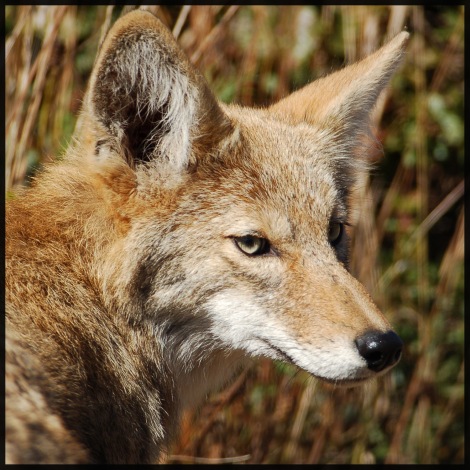
Coyote (Canis latrans). Photo by Matt Knoth from Wikimedia Commons
So what can we do? The coyote has a right to live and survive. Nor do we need to fear them or see them as a threat. There are far greater dangers in the city. Public awareness and education are key.
It is important that coyotes don’t get habituated to people. In other words, they need to know who’s the boss. The most important part of this is to not have them associate people with food. Never feed a coyote. Pets should be feed indoors, or if feed outdoors, make sure the food isn’t left out unattended. Food that is thrown out should be in an enclosed bag and tossed into a secure trash can. If there are fruit trees, pick up fallen fruit. Do not put meat or dairy products in the compost pile.
Of course, small children should not be outside unsupervised Pets like cats, small dogs, rabbits and chickens should also be watched when outside or be in a secure enclosure. To secure a backyard from coyotes, fences need to be eight feet high or six feet with ‘coyote rollers,’ and extend 6 inches beneath the ground.
The Humane Society has a web page and booklet about living with coyotes and hazing them. And no, I’m not referring to getting coyotes drunk and having them run naked across campus. Hazing is used to make coyotes wary of human beings. It can be as simple as not changing your path when a coyote appears on it. Raise your arms, yell and howler till they leave. People can use noisemakers, squirt guns or throw small rocks and sticks at the coyotes. Never run away. However, if the coyote is injured or appears sick, leave them alone and call animal control or a wildlife rescue organization. See also Co-existing with Coyotes from Santa Monica National Recreation Area.
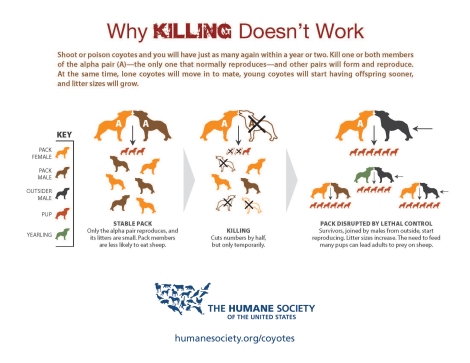
Graphic from the Humane Society of the United States
Problematic coyotes may need to be removed from the population. This can be controversial. Baker and Timm write that removing a problematic individual can also make the other coyotes in the area more wary of people. But as we seen, indiscriminet killing of coyotes has proven to be ineffective and will cause the population to spread and move into new areas. One thing that Dan Flores discusses in ‘Coyote America’ is one effect of killing off large number of coyotes is the disruption to the coyote culture. When the alpha animal is killed off, more pairs of coyotes start not only breeding, but without the alpha’s guidance start going after prey that is not normally part of their diet (small mammals, mostly rodents). He discussed this in terms of sheep, but I can easily see this being the case with pets.
The feral cat population presents a unique problem. In general, coyote diets are made up of small mammals such as mice, rats and gophers. But they can also go for larger prey – rabbits, groundhogs and, sometimes, even cats. Studies done on coyote diets indicate in urban areas, pets and feral cats can make up a very small percentage of their diet, though coyotes are very individualistic and some have made a regular habit of eating cats. Current studies being done on urban coyotes who don’t live near any open habitat may change our understanding of their diet.

Photo by U.S. Fish and Wildlife Service from Wikimedia Commons
So feral cats do offer a source of food for coyotes. Not helping the situation is people who leave food out for the feral cats. This food also attracts coyotes, not to mention other urban wildlife. I know many people care greatly for feral cats and like to tote how they help keep the rodent population in control. And, of course, pet owners need to be responsible to make sure their cats don’t become feral. Yet a cat, once left to fend for itself, is no longer a pet but a part of the ecosystem. It is estimated the cats kill over a billion birds and over six billion small mammals a year in the United States, the majority of the kills from feral cats (nature.com). In highly developed urban areas, these mammals can mostly be non-native rodents that have adapted to human environments – the house mice and rats we usually think of. But in suburban or rural areas, up to 75% of the mammals killed are native animals. Several studies have indicated that the presence of coyotes can be an important factor in keeping bird populations stable (conservationmagazine.org), (nhm.org).
The truth is we are only beginning to come to understand the role coyotes play in an urban setting. It is far more complex than them being just cat-eaters. Nature, whether in the wild or in the city, is a complex web. What may seem to be problematic to us can actually be part of a vital function. We have to let go of the idea that we can control nature and make it fit in neat categories of ‘good’ and ‘bad.’ And we need to be careful of the idealize live and let live mentality that can make us forgetful of the dangers. While we can’t control, we can try to manage. With the coyote that means giving them space to live, recognizing their right to live, but making sure they don’t get too comfortable around us.
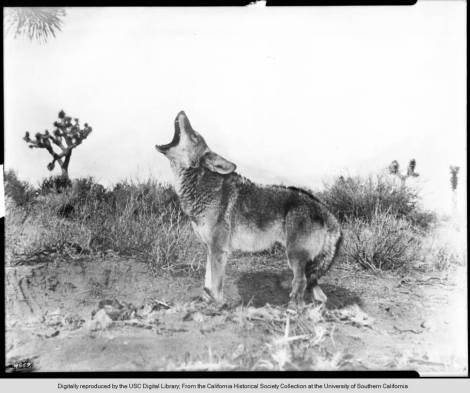
From circa 1900, a coyote howls out in the desert. Photo from USC Digital Library
For me, I want the coyote around. The more I learn about them, the more fascinating they become. Intelligent, resourceful, creative, they have thrived under persecution where other animals were vanquished. Perhaps they can be reminders that we aren’t the only game in town, that even in our concrete jungles we share this land with others.
For a fuller understanding of coyotes and their history, I strongly recommend ‘Coyote America’ by Dan Flores (Basic Books).
A great source of information on urban coyotes, go to (Urban Coyote Research)
Addendum (3/23/18): An interesting article from the L.A. Times about the urban coyote diet: How do Coyotes Thrive in Urban Southern California
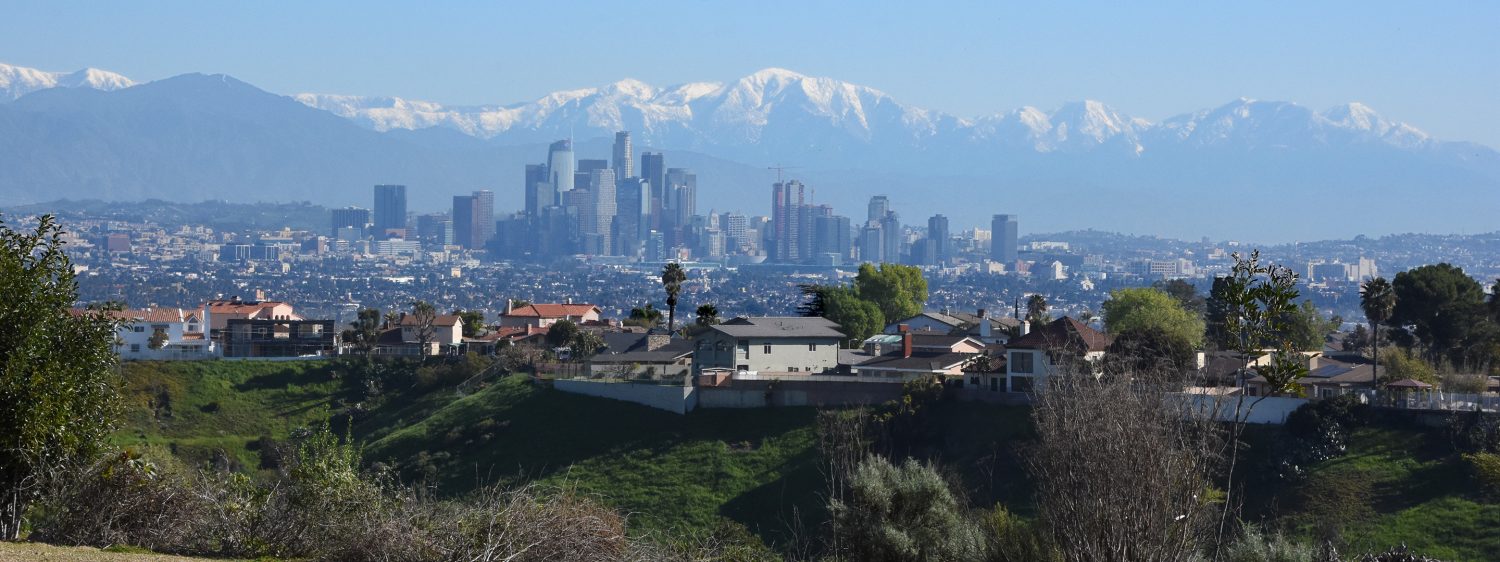
Differences in animal behavior in different regions/settings can be pretty interesting. Here in rural central Colorado, the coyotes tend to be very elusive; we see plenty of tracks but rarely glimpse the animal. If I see one while I’m driving, they’re indifferent unless I slow down, in while case they usually take off at a full run.
LikeLiked by 1 person
Yes, those in more urban areas are almost like stray dogs. I can actually talk to coyotes in Franklin Canyon Park in Beverly Hills. They just look at me funny, but are not too alarmed. Those here in more suburban Santa Cruz County are quite tame as well, but keep more of a distance.
LikeLiked by 1 person
I think part of the reason is coyotes in the city not only get use to humans but they realize we aren’t going to shoot at them! Plus we leave a lot of yummy trash behind…
LikeLike